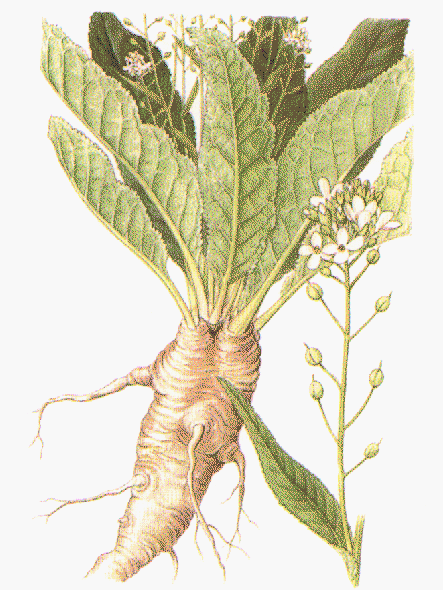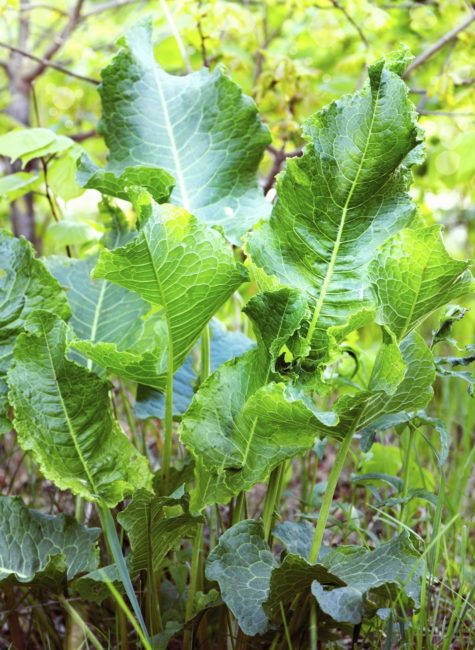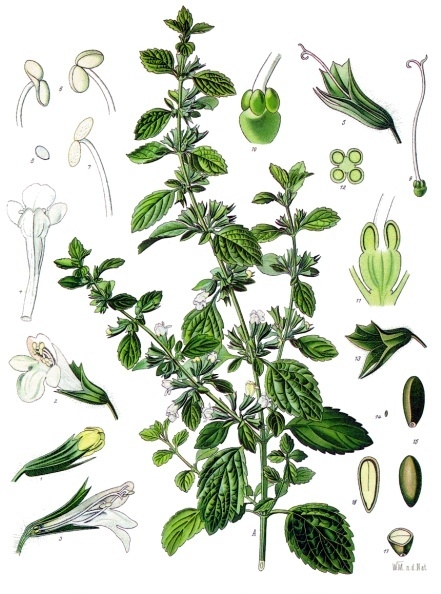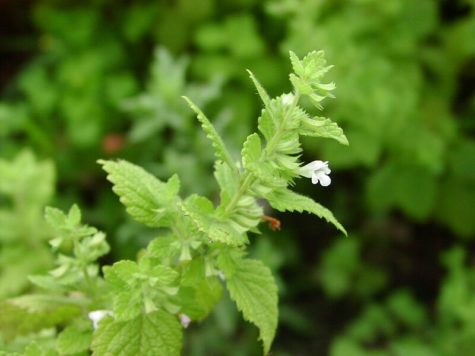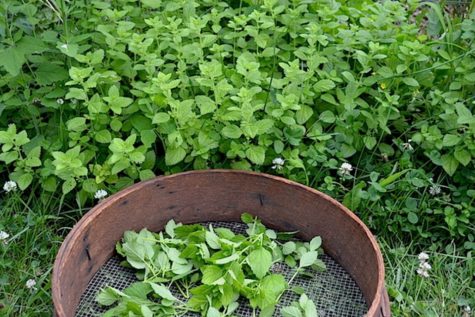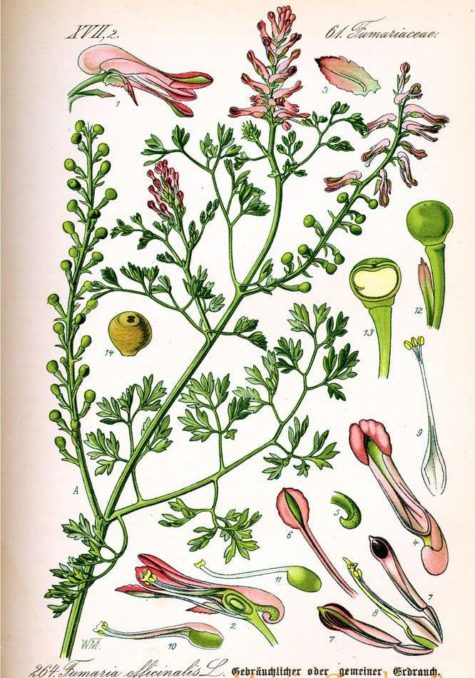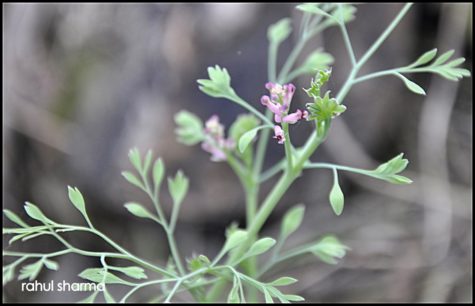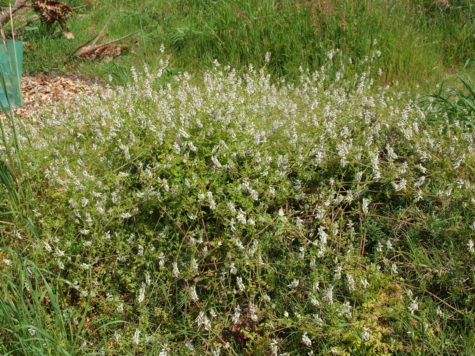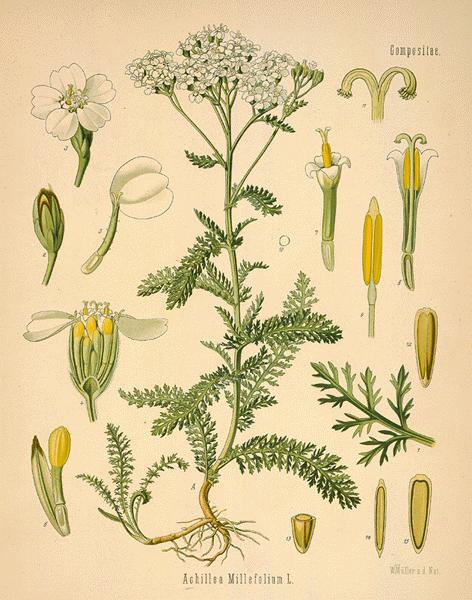Hepatic
Horseradish
- Scientific name: Armoracia rusticana
- Family: Cruciferae
- Parts Used: Tap root, leaves (occasionally)
- Actions: Stimulant, Carminative, Rubefacient, mild Laxative, Diuretic, Hepatic, Vermicide
The Egyptians knew about horseradish as far back as 1500 B.C. Early Greeks used it as a rub for lower back pain and an aphrodisiac. Jews still use it during Passover seders as one of the bitter herbs. Some used horseradish syrup as an expectorant cough medicine; others were convinced it cured everything from rheumatism to tuberculosis. Legend has it the Delphic oracle told Apollo, “The radish is worth its weight in lead, the beet its weight in silver, the horseradish its weight in gold.”
Horseradish is an old household remedy useful wherever a stimulating herb is called for. It can be used in influenza and fevers as a rough equivalent to Cayenne Pepper. It stimulates the digestive process whilst easing wind and griping pains. It has been used in cases of urinary infection. Externally it has a stimulating action similar to Mustard Seed. It can be used for rheumatism and as a poultice in bronchitis.
Fresh horseradish root contains calcium, magnesium, sodium, vitamin C, and has antibiotic qualities. According to WebMD, Horseradish might help fight bacteria and stop spasms.
A tea or decoction of horseradish is antiseptic, stimulant, laxative and strongly diuretic, but as it becomes a purgative when taken in large doses it is best to be cautious. It is often best used when applied externally. Apply grated fresh root to aching joints and chilblains, or infuse it in milk as a skin tonic. Traditionally taken to expel worms, horseradish has only been used as a food during the last two or three hundred years.
This plant has been in cultivation from the earliest times, but its exact place of origin seems to be obscure. It is probably the plant mentioned by Pliny under the name of Amoracia, and recommended by him for its medicinal qualities, being then apparently employed exclusively in physic, not as food or condiment. Both the root and the leaves of Horseradish were universally used as a medicine during the middle ages.
Description
Horseradish is a perennial with large, narrow, sometimes deeply cut leaves and a thick, tapering, fleshy root. In temperate climates long, loose panicles of white, four-petaled flowers occasionally appear in midsummer, but the seeds seldom ripen.
Lemon Balm
- Scientific Name: Melissa officinalis
- Plant Family: Laviatae
- Parts Used: Leaves – fresh or dried
- Actions: Carminative, Anti-spasmotic, Anti-depressive, Diaphoretic, Hypotensive, Anti-emetic, Hepatic, Nervine, Tonic
- Constituents: Rich in essential oil containing citral, citronellal, geraniol and lindol; bitter principles, flavones, resin.
- How does it work? Lemon balm contains chemicals that seem to have a sedative, calming effect. It might also reduce the growth of some viruses.
General Overview:
A member of the mint family, lemon balm is considered a “calming” herb. It has been used for centuries to help heal wounds, treat venomous insect bites and stings, induce relaxation and a sense of well being, improve appetite and aid digestion. Lemon balm, known and named for its fresh, lemony scent, has long been used as a culinary, cosmetic and medicinal and magical herb.
Note: Lemon Balm, though often called Bee Balm, should not be confused with another plant commonly called Bee Balm (Mondara dydima).
The botanical name, melissa, is Greek for “bee”. Lemon balm has been cultivated in the Mediterranean region for about 2000 years. The Muslim herbalist Avicenna recommended lemon balm “to make the heart merry”. Paracelsus claimed this herb could completely revitalize the body and called it the “elixir of life”, and 14th century French King Charles V drank its tea every day to keep his health.
Lemon balm is used for digestive problems, including upset stomach, bloating, intestinal gas (flatulence), vomiting, and colic; for pain, including menstrual cramps, headache and toothache; and for mental disorders, including hysteria and melancholia.
Lemon balm is excellent for treating anxiety and battling some hard-to-treat viruses. The list of symptoms from anxiety is vast but melissa tackles them all bravely. It is equally fearless when it comes to taking on viruses as daunting as Mono and Herpes. This is an herb every healer wants in the medicine cabinet.
In Ayruvedic medicine, Lemon Balm’s energy is pungent, sour-sweet, cool, and wet. Crushed leaves rubbed on the skin in the garden helps keep away bugs.
Many people believe lemon balm has calming effects so they take it for anxiety, sleep problems, and restlessness. Lemon balm is also used for Alzheimer’s disease, attention deficit-hyperactivity disorder (ADHD), an autoimmune disease involving the thyroid (Graves’ disease), swollen airways, rapid heartbeat due to nervousness, high blood pressure, sores, tumors, and insect bites.
Lemon balm is inhaled as aromatherapy for Alzheimer’s disease. Some people apply lemon balm to their skin to treat cold sores (herpes labialis).
Description:
A familiar garden plant with its fresh, green, nettle shaped leaves and strong bushy growth, lemon balm is native to southern Europe and was probably introduced to the north by the Romans. The creamy flowers are undistinguished and grow in loose clusters from midsummer. The hardy root is perennial.
Lemon balm has the square stems indicative of the mint family with green, oval, finely toothed leaves that grow opposite each other on the stem. The leaves also have fine hairs that capture morning dew and helps keep the plant moist. Flowers are small and yellow to white depending on soil type. It can vary in height between 12 inches to well over 3 feet.
Cultivation:
Easy to grow and tolerant of most soils, it does especially well on a fairly rich, moist ground in a sheltered, sunny position. Sow seeds in the spring or late summer; divide the roots in the fall or early spring; take cuttings in the summer. Keep the plants well weeded.
It prefers moist, not soggy, loamy soil in full sun but will develop more volatile oils when grown in drier, shadier soils. It can tolerate a vast pH range from 5 to 8 in the soil. Lemon balm flowers in the summer and provides an excellent source of nectar for bees and hummingbirds.
Barely cover seed to germinate in 1-2 weeks at room temperature. Set out at 12-15 inches apart in full sun and rich soil. This perennial plant typically gets 12-18 inches tall.
Like any mint, it can be aggressive–it spreads by runners, self-seeds, and can be propagated by cuttings. But it’s a plant, not a monster. I have my lemon balm in partial shade, next to my cabbages and some other aromatic herbs. It has formed some nice thick clumps in two years, but it is not taking over the garden by any means. If you feel concerned, plant it in a pot and sink the pot in the soil.
It is hardy to zone 4: -30°F. It is a good companion plant for members of the brassica family, and deer don’t usually eat it. For drying, harvest leaves just before or after it flowers. Don’t harvest when it’s wet or the leaves will discolor.
Collection
Leaves may be harvested two or three times a year between early summer and early fall. They are gathered by cutting off the young shoots when they are approximately 12 in long. Harvest them for drying as the flowers begin to open. Dry quickly and carefully in the dark, or in the shade, to preserve their color. They should be dried at a temperature not above 95° F.
Unlike other herbs which are at their best when the dew has dried off them in the morning, Lemon Balm should be harvested in mid to late afternoon when the oils are strongest.
Lemon balm can be harvested for fresh use once or twice a week and leaves can be kept in the fridge for a few days, or be frozen. Leaves should be handled delicately as they tend to bruise and turn black.
Hang sprigs to dry in dark cool place. Be sure to keep out of moisture, as leaves are prone to browning and more susceptible to mold. Store dried leaves in air tight container. The leaves lose some of their flavor when dried.
Medicinal Uses
Lemon balm is an excellent carminative herb that relieves spasms in the digestive tract and is used in flatulent dyspepsia. Because of its anti depressive properties, it is primarily indicated where there is dyspepsia associated with anxiety or depression, as the gently sedative oils relieve tension and stress reactions, thus acting to lighten depression.
A little patch of lemon balm in the garden, particularly near the bedroom windows, brings uplifting energy on dark days. We get a lot of cloudy days here in the Pacific Northwest. I’ve found that a bit of lemon balm growing in close proximity to my home brings just enough sunny energy to give my family the lift we need during long spans of dark weather. When the going gets particularly tough, we pick a few sprigs for our drinking water, but most of the time Lemon Balm’s presence is enough. Continue reading
Fumitory
- Scientific name: Fumaria officinalis
- Family: Fumariaceae
- Medical Action: Laxative, alterative, cholagogue, hepatic, diuretic, and aperient, a weak tonic, slightly diaphoretic,
- Constituents: Alkaloids, bitter principle, mucilage, fumaric acid, amino acids, resin. The plant contains isoquinoline alkaloids protopine and allocryptopine.
- Parts Used: Leaves
- Other Fumitories: American Fumitory Fumaria Indica, or Codder Indian
The Basics
Earth smoke, as it is also called, is a wild poppy plant traditionally used as an incense herb with a stimulating effect on liver and gallbladder and as a protection against skin diseases and eczema. The drug fumitory is toxic in high doses.
Fumitory has been known since antiquity and was described in herbals from the Middle Ages. Fumitory is a predominantly Mediterranean genus that once was used medicinally. Traditional preparation involved expressing the juice and evaporating it. It has been used as a laxative and diuretic.
Fumaria species are used in Turkish folk medicine as a blood purifier and an anti-allergic agent.
In traditional medicine, the plant has been used to treat eczema and other dermatologic conditions. It was thought to be good for the eyes, and to remove skin blemishes. In modern times herbalists use it to treat skin diseases, and conjunctivitis; as well as to cleanse the kidneys.
Fumitory has a long history of use in the treatment of skin problems such as eczema and acne. Its action is probably due to a general cleansing mediated via the kidneys and liver. Fumitory may also be used as an eyewash to ease conjunctivitis.
The name is said to be derived either from the fact that its whitish, blue-green colour gives it the appearance of smoke rising from the ground, or, according to Pliny, because the juice of the plant brings on such a flow of tears that the sight becomes dim as with smoke, and hence its reputed use in affections of the eye.
Constituents
The leaves yield by expression a juice which has medicinal properties. An extract, prepared by evaporating the expressed juice, or a decoction of the leaves, throws out upon its surface a copious saline efflorescence. Fumaric acid was early identified as present, and its isomerism with maleic acid was established later.
The alkaloid Fumarine has been believed to be identical with corydaline, but it differs both in formula and in its reaction to sulphuric and nitric acids. It occurs in colourless, tasteless crystals, freely soluble in chloroform, less so in benzine, still less so in alcohol and ether, sparingly soluble in water.
Etymology
The “smoky” or “fumy” origin of its name comes from the translucent color of its flowers, giving them the appearance of smoke or of hanging in smoke, and the slightly gray-blue haze color of its foliage, also resembling smoke coming from the ground, especially after morning dew.
The plant was already called fūmus terrae (smoke of the earth) in the early 13th century, and two thousand years ago, Dioscorides wrote in De Materia Medica and Pliny the Elder in Naturalis Historia that rubbing the eyes with the sap or latex of the plant causes tears, like acrid smoke (fūmus) does to the eyes. Continue reading
Yarrow
- Scientific Name: Achillea millefolium
- Plant Family: Compositae
- Parts Used: The whole plant – stems, leaves, flowers, collected in the wild state, in August, when in flower.
- Actions: Diaphoretic, Hypotensive, Astringent, Diuretic, Antiseptic, Anticatarrhal, Emmenagogue, Hepatic, Stimulant, Tonic, Mild Aromatic
The Basics:
Yarrow is a wound herb, astringent and healing, and rich in vitamins and minerals. Bind bruised fresh leaves to cuts, or make an ointment by pounding the flowers and mixing with coconut oil, or bathe wounds with yarrow tea. The tea is also a good tonic drink, it restores lost appetite and promotes perspiration during colds and fevers. Chew fresh leaves to soothe toothache.
Yarrow also lowers blood pressure due to a dilation of the peripheral vessels. It stimulates the digestion and tones the blood vessels. As a urinary antiseptic it is indicated in infections such as cystitis. It is considered to be a specific in thrombotic conditions associated with high blood pressure.
The flowers are often steamed and inhaled to treat hay fever and asthma and in teas for respiratory problems, as a wash for eczema and other skin conditions; and in chest rubs for cold, flu, and inflamed joints. Continue reading
Rennie Luttrull: queen-annes-lace-seeds
Rosanna: Spignel aka Bald Money
Annamarie Squatrito: Fumitory
EILEEN Klinghagen: Pumpkin
Mahmudul Hasan: Celery
